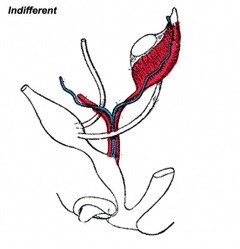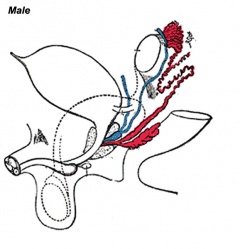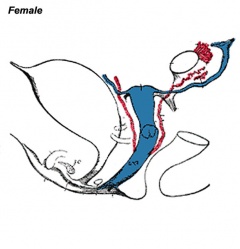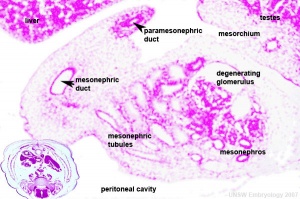Prostate Development: Difference between revisions
(→Mouse) |
No edit summary |
||
| Line 1: | Line 1: | ||
<div style="background:#F5FFFA; border: 1px solid #CEF2E0; padding: 1em; margin: auto; width: 98%; float:left;"><div style="margin:0;background-color:#cef2e0;font-family:sans-serif;font-size:120%;font-weight:bold;border:1px solid #a3bfb1;text-align:left;color:#000;padding-left:0.4em;padding-top:0.2em;padding-bottom:0.2em;">Notice - Mark Hill</div>Currently this page is only a template and is being updated (this notice removed when completed).</div> | |||
== | == Introduction == | ||
The male and female reproductive systems develop initially "indifferently", it is the product of the Y chromosome SRY gene that makes the "difference". The mesonephric duct (Wolffian Duct) contributes the majority of male internal genital tract. The embryonic gonad development leads to the mesonephric/paramesonephric duct changes, while the external genitaila remain indeterminate in appearance through to the fetal period. Importantly its sex chromosome dependence, late embryonic/fetal differential development, complex morphogenic changes, long time-course, hormonal sensitivity and hormonal influences make it a system prone to many different abnormalities. | |||
The prostate gland is generally recognised due to its late postnatal adult growth changes, rather than its embryonic development, and the health effects of prostate cancer. | |||
There are also currently separate pages describing [[Spermatozoa Development]] | [[Testis Development]] | [[Prostate Development]]. | |||
:{{Template:Genital Links}} | [[Puberty Development|Puberty]] | |||
== Some Recent Findings == | |||
[[File:Stage22_mesonephros.jpg|thumb|Male urogenital development (stage 22)]] | |||
{| | |||
|-bgcolor="F5FAFF" | |||
| | |||
* '''Temporal and spatial dissection of Shh signaling in genital tubercle development.'''<ref><pubmed>19906863</pubmed></ref> "Genital tubercle (GT) initiation and outgrowth involve coordinated morphogenesis of surface ectoderm, cloacal mesoderm and hindgut endoderm. GT development appears to mirror that of the limb. Although Shh is essential for the development of both appendages, its role in GT development is much less clear than in the limb. Here, by removing Shh at different stages during GT development in mice, we demonstrate a continuous requirement for Shh in GT initiation and subsequent androgen-independent GT growth." | |||
|} | |||
== Textbooks == | |||
* '''Human Embryology''' (2nd ed.) Larson Chapter 10 p261-306 | |||
* '''The Developing Human: Clinically Oriented Embryology''' (6th ed.) Moore and Persaud Chapter 13 p303-346 | |||
* '''Before We Are Born''' (5th ed.) Moore and Persaud Chapter 14 p289-326 | |||
* '''Essentials of Human Embryology''', Larson Chapter 10 p173-205 | |||
* '''Human Embryology''', Fitzgerald and Fitzgerald Chapter 21-22 p134-152 | |||
* '''Developmental Biology''' (6th ed.) Gilbert Chapter 14 Intermediate Mesoderm | |||
==Mouse Prostate== | |||
Androgenic regulation of ventral epithelial bud number and pattern in mouse urogenital sinus.<ref><pubmed>19941349</pubmed></ref> | |||
* begins in fetal mice ductal progenitors (or buds) emerge from urogenital sinus epithelium | * begins in fetal mice ductal progenitors (or buds) emerge from urogenital sinus epithelium | ||
| Line 8: | Line 36: | ||
[[Mouse Development]] | [[Mouse Development]] | ||
==Movies== | |||
Genital development animations | |||
{| border='0px' | |||
|- | |||
| [[File:Urogenital_sinus_001 icon.jpg|90px|link=Development_Animation_-_Urogenital_Sinus]] | |||
| [[File:Urogenital_septum_001 icon.jpg|90px|link=Development_Animation_-_Urogenital_Septum]] | |||
|- | |||
| [[Development_Animation_-_Urogenital_Sinus|Urogenital Sinus]] | |||
| [[Development_Animation_-_Urogenital_Septum|Urogenital Septum]] | |||
|- | |||
| [[File:Male_external_001 icon.jpg|90px|link=Development_Animation_-_Genital_Male_External]] | |||
| [[File:Testis_001 icon.jpg|90px|link=Development_Animation_-_Testis_Descent]] | |||
|- | |||
| [[Development_Animation_-_Genital_Male_External|Male External]] | |||
| [[Development_Animation_-_Testis_Descent|Testis Descent]] | |||
|- | |||
|} | |||
== Development Overview == | |||
Three main stages during development, mesonephric/paramesonephric duct changes are one of the first male/female differences that occur in development, while external genitaila remain indeterminate in appearance for quite a while. | |||
# Differentiation of gonad (Sex determination) | |||
# Differentiation of internal genital organs | |||
# Differentiation of external genital organs | |||
The 2nd and 3rd stages dependent on endocrine gonad. Reproductive development has a long maturation timecourse, begining in the embryo and finishing in puberty. (More? [[Puberty Development]]) | |||
===Historic Images of Genital Changes=== | |||
{| | |||
| [[File:Urogenital indifferent.jpg|240px|Urogenital Indifferent]] | |||
| [[File:Urogenital male.jpg|240px|Urogenital Male]] | |||
| [[File:Urogenital female.jpg|240px|Urogenital Female]] | |||
|- | |||
| Urogenital indifferent | |||
| Urogenital male | |||
| Urogenital female | |||
|} | |||
==Additional Images== | |||
<gallery> | |||
File:Stages_of_primordial_germ_cell_migration.jpg|Stages of primordial germ cell migration<ref><pubmed> 20027186</pubmed>| [http://www.nature.com/nrm/journal/v11/n1/abs/nrm2815.html Nature Reviews Molecular Cell Biology]</ref> | |||
</gallery> | |||
== References == | |||
<references/> | |||
===Reviews=== | |||
===Articles=== | |||
===Search PubMed=== | |||
'''Search Pubmed:''' [http://www.ncbi.nlm.nih.gov/sites/entrez?db=pubmed&cmd=search&term=male%20genital%20system%20development Male Genital System Development] | [http://www.ncbi.nlm.nih.gov/sites/entrez?db=pubmed&cmd=search&term=mesonephric%20duct mesonephric duct] | |||
==Terms== | |||
{{Template:Glossary}} | |||
{{Template:Footer}} | |||
Revision as of 08:11, 28 October 2010
Introduction
The male and female reproductive systems develop initially "indifferently", it is the product of the Y chromosome SRY gene that makes the "difference". The mesonephric duct (Wolffian Duct) contributes the majority of male internal genital tract. The embryonic gonad development leads to the mesonephric/paramesonephric duct changes, while the external genitaila remain indeterminate in appearance through to the fetal period. Importantly its sex chromosome dependence, late embryonic/fetal differential development, complex morphogenic changes, long time-course, hormonal sensitivity and hormonal influences make it a system prone to many different abnormalities.
The prostate gland is generally recognised due to its late postnatal adult growth changes, rather than its embryonic development, and the health effects of prostate cancer.
There are also currently separate pages describing Spermatozoa Development | Testis Development | Prostate Development.
| Puberty
Some Recent Findings
|
Textbooks
- Human Embryology (2nd ed.) Larson Chapter 10 p261-306
- The Developing Human: Clinically Oriented Embryology (6th ed.) Moore and Persaud Chapter 13 p303-346
- Before We Are Born (5th ed.) Moore and Persaud Chapter 14 p289-326
- Essentials of Human Embryology, Larson Chapter 10 p173-205
- Human Embryology, Fitzgerald and Fitzgerald Chapter 21-22 p134-152
- Developmental Biology (6th ed.) Gilbert Chapter 14 Intermediate Mesoderm
Mouse Prostate
Androgenic regulation of ventral epithelial bud number and pattern in mouse urogenital sinus.[2]
- begins in fetal mice ductal progenitors (or buds) emerge from urogenital sinus epithelium
- prostatic buds develop in response to androgens, which activate androgen receptors in UGS mesenchyme
- two rows of 3-4 prostatic buds at birth
Movies
Genital development animations
| Urogenital Sinus | Urogenital Septum |
| Male External | Testis Descent |
Development Overview
Three main stages during development, mesonephric/paramesonephric duct changes are one of the first male/female differences that occur in development, while external genitaila remain indeterminate in appearance for quite a while.
- Differentiation of gonad (Sex determination)
- Differentiation of internal genital organs
- Differentiation of external genital organs
The 2nd and 3rd stages dependent on endocrine gonad. Reproductive development has a long maturation timecourse, begining in the embryo and finishing in puberty. (More? Puberty Development)
Historic Images of Genital Changes

|

|

|
| Urogenital indifferent | Urogenital male | Urogenital female |
Additional Images
Stages of primordial germ cell migration[3]
References
- ↑ <pubmed>19906863</pubmed>
- ↑ <pubmed>19941349</pubmed>
- ↑ <pubmed> 20027186</pubmed>| Nature Reviews Molecular Cell Biology
Reviews
Articles
Search PubMed
Search Pubmed: Male Genital System Development | mesonephric duct
Terms
Glossary Links
- Glossary: A | B | C | D | E | F | G | H | I | J | K | L | M | N | O | P | Q | R | S | T | U | V | W | X | Y | Z | Numbers | Symbols | Term Link
Cite this page: Hill, M.A. (2024, May 2) Embryology Prostate Development. Retrieved from https://embryology.med.unsw.edu.au/embryology/index.php/Prostate_Development
- © Dr Mark Hill 2024, UNSW Embryology ISBN: 978 0 7334 2609 4 - UNSW CRICOS Provider Code No. 00098G

![Stages of primordial germ cell migration[3]](/embryology/images/thumb/5/5f/Stages_of_primordial_germ_cell_migration.jpg/114px-Stages_of_primordial_germ_cell_migration.jpg)